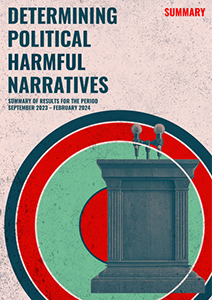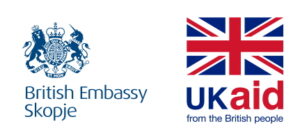
Determining Political Harmful Narratives: Six-month Report
Period: September 2023- February 2024
Short Version
Full Version
The Institute of Communication Studies (ICS) published a six-month report on the research "Determining Political Harmful Narratives" (HARM-TIVE). This report synthesizes data from the past six months, from September 2023 to February 2024, on how political actors communicate and how harmful narratives are disseminated in the media. It consolidates the findings from three bimonthly monitoring reports to track trends in harmful communication practices and assess changes in toxic rhetoric as elections near.
The analysis revealed that over a third of all communications from political parties and leaders involved harmful narratives. These often involved unsubstantiated accusations aimed at undermining trust in institutions and presenting information selectively, hindering the public's ability to get a full understanding of political operations and make informed choices. Nearly as frequently, these narratives included attacks and demonization, fomenting divisions, and promoting populism.
The two largest political parties, VMRO-DPMNE and SDSM, are the leading sources of harmful narratives, closely followed by the political party Levica. Out of a total of 797 posts containing harmful narratives, 732, or 92%, were produced by these three parties alone (VMRO-DPMNE with 311 posts, SDSM with 228 posts, and Levica with 193 posts). Among individual political leaders, Dimitar Apasiev from Levica is the most prolific in disseminating harmful narratives, with 50 such posts over six months. He is followed by Hristijan Mickoski from VMRO-DPMNE with 17 posts, and Izet Medjiti from the Democratic Movement with 11 posts.
During this monitoring period, the research identified 26 instances of harmful narratives across posts made by government officials. Among these, Jeton Shaqiri and Jovanka Trenchevska each posted one harmful narrative, Dimitar Kovachevski posted two, and Krenar Loga posted the highest number, with six. Additionally, some government ministers were noted for misusing their official platforms for self-promotion and political advantages without engaging in harmful narratives.
In the monitoring of television networks, analysts found 484 news items containing harmful narratives. TV Alfa recorded the highest number at 182 news items, while TV 24 Vesti had the fewest, with just 15. Online media outlets posted a total of 1,236 news items featuring harmful narratives. Republika led with 265 harmful news items, whereas Nova TV had the fewest, publishing only 32.
The three most common harmful narratives produced by political figures, which were also prevalent in TV and online media, are: (1) undermining trust in institutions, (2) biased selection of information, and (3) attacks and demonization of political opponents. Other frequently observed themes include disinformation, fomenting divisions, and populism.
Contact:

